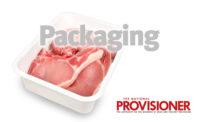Keeping It Fresh
BY LISA WHITE
When it comes to deli meat, the preference for packaging is geared toward convenience, reusability and aesthetics.
The evolution of deli meat packaging has taken place over the last 10 years. During this period, packaging that was not reusable and difficult to open was replaced with state-of-the-art packaging that provides a longer shelf life, easy access and reusability.
Looking back, press-to-close packaging has been used for cheese since about 1985, and made its way into the deli meat segment in the early 1990s.
It wasn’t until the late 1990s that sliders were developed. This improved zipper-type enclosure provided easier use and a more foolproof application. The new design also provided relief for consumers, including aging baby boomers, who had difficulty lining up the zipper properly. Processors also appreciated the affordability of this feature.
Fast-forward to today, and the latest innovation in deli meat packaging is the rigid, resuable plastic-type tub container. This value-added packaging offers processors the ability to customize the shapes, styles and graphics on these containers to help distinguish their products from others. Also, consumers like the storing capabilities and the fact that this packaging can be reused after the deli meat is long gone.
With the growing number of aging Americans, convenience and usability are key factors in the packaging segment. Consumers also want fresh product and are willing to pay a premium for packaging that provides this.
For processors, sliders and plastic tubs allow their product name to stay in front of the consumer for a longer period, since they are not transferring deli meat into generic zipper bags.
Both sliders and plastic tubs offer a number of advantages.
Sliders
Monteno, Ill.-based Zip-Pak, a leader in resealable packaging technology, has worked with packaging equipment and film companies over the years to provide press-to-close zippers for the sliced meat industry. The company also works with major film converters, using different films and sealant layers.
Recently, Zip-Pak has upgraded to slider technology. According to Bob Hogan, director of international sales and marketing, over the years the company has continued to improve its zipper design to make it easier and foolproof.
“Our research shows that consumers believe this is the easiest way to open and reseal packages,” he explains. “This is especially the case for young children and seniors. Our respondents now say there is no excuse not to reseal the package properly.”
Hogan says sliders offer a number of benefits to consumers. “Often, sliced-lunchmeat packages come in multi-portion sizes. If, after making a sandwich, there is more meat to be used, consumers expect the package to be resealable,” he says. “They [also] don’t want product leaks in the deli tray.”
Lake Forest, Ill.-based Pactiv, a leading producer of specialty-packaging products for the consumer and foodservice/food packaging markets, introduced a new slider inserter at the Pack Expo Show in Chicago in October. According to Steve Meli, national accounts manager, the new packaging design is extremely inexpensive and simplified.
“These new slider inserters easily attach to the base of whatever packaging equipment processors have,” he says. The footprint of this system also has been significantly reduced.
“The size varies, depending upon the application, but it is about 25 percent smaller in size. In addition, it costs about half the price as other similar systems,” Meli says.
Although he says the new tub packaging geared for deli meat took a significant chunk out of sliders’ market share, he is seeing a lot of that business come back.
“The real key to our business is being creative with new designs toward packaging,” he says. “We are especially seeing a revival and interest of sliders in the deli meat sector, in addition to hot dogs and bacon.”
The biggest trend Hogan sees in deli packaging is in larger formats. “There are a lot of one-pound deli-meat packages,” he says. “For these sizes, the zipper technology allows for easy opening and resealing.”
By working with film and machinery companies, Zip-Pack can put packaging together with this easy-open feature using machine-perforating film. Of course, since sliders are a value-added feature, Hogan says they are a bit more expensive.
“But when they are added to larger format packages that carry a higher price tag, this cost can easily be absorbed by processors,” he explains.
Consequently, processors including Oscar Mayer, Smithfield, Buddig and Plumrose, have incorporated sliders into their deli meat packaging.
Tubs
Much of the focus in deli meat packaging recently has been on the tubs, or reusable plastic packaging, that were first introduced by Sara Lee for its Hillshire Farms brand back in 2002.
Today, a number of processors have added this packaging to their deli meat lines due to its popularity with consumers. It is important to note that plastic tubs are secondary packaging used for holding vacuum-packaged deli meats.
Fort Wayne, Ind.-based Mullinix Packages was the original developer of Gladware containers back in the mid 1990s. Today, the company offers a deli container line designed for sliced luncheon meats.
According to Brian Schmitz, vice president of sales and marketing, the polypropylene containers are available in 16-, 24-, 32- and 64-ounce sizes. “The 16- and 24-ounce containers have the same pop-out opening or footprint and utilize the same plug-fit lid. This also is the case with the 32- and 64-ounce sizes,” Schmitz says. This allows manufacturers to switch from the two sizes without changing over their lines.
From a consumer standpoint, Schmitz says this is an economical way to have containers for leftovers or packing lunches.
“The packaging has an added cost to it, but we’ve found that consumers are willing to pay a little more for value-added offerings. They feel they are getting something of convenience,” Schmitz says. Many regional processors are realizing the consumer appeal and popularity of these containers.
“We are seeing a lot of regional meat processors getting on the bandwagon to supply regional supermarkets and club stores with these products,” he adds. “We also are seeing trends in 64-ounce tub containers with mixed 10-ounce packages of meat and 32-ounce containers for larger portions of single lines.”
Presto Products Co., part of Alcoa Consumer Products, based in Appleton, Wis., a leading supplier of products ranging from private-label food and disposer bags to packaging closures to soil-stabilization materials to specialty stretch films, is a provider of zipper enclosures and has offered Fresh-Lock polypropylene containers for about three years. Tom Winter, product manager, says these containers are big business today.
“We have seen substantial growth,” he says. “These products give processors the opportunity to get brand identification in front of their customers because the shape and packaging is different. Processors can customize the shape of containers and the color on the lids to coincide with their logos. There are virtually no limitations. This helps differentiate their lines.”
The Fresh-Lock line offers a number of standard sizes geared for deli meat. The Entrée size is 25 ounces. The Soup and Salad, the most popular in the deli meat segment, is 24 ounces. For club stores and larger volume meats, Presto Products offers a 64-ounce container.
From a storability standpoint, Winter says these containers are easily stacked and stored. “They also can be used long after meat is gone. The tubs are dishwasher safe and can be used for reheating in the microwave. They also can be used for storing food in the freezer,” he says.
Looking Ahead
What does the future hold for the deli meat packaging segment? Newer products and technologies are on the horizon that will provide processors with even more choices for their products.
For example, Coextruded Plastic Technologies, an Edgerton, Wis.-based packaging provider, recently introduced a new high-barrier bottom clear tub that is sealed with a barrier lidded film and a snap-on lid.
“We brought the technology over from Europe,” says Linda Bracha, president. “We use the whole tub and the one piece of lidding film, as opposed to meat being contained in a vacuum pouch and placed in the tub. This method keeps the modified-atmosphere packaging inside the tub as opposed to using a vacuum package.”
Consumers simply remove the lid and peel back the lidding film. This packaging method is currently being used for deli meat overseas, but has not yet been adopted by processors in the U.S.
“We are targeting the American deli meat segment for this new technology,” Bracha says. Schmitz predicts that the use of polypropylene containers will eventually move toward the full-service deli.
“We have a large portion of our business in the generic and private-label market, and we think the natural extension of these containers is at the deli counter,” he says. “Being able to purchase the same container in the deli for cheese, lunchmeat or potato salad further drives the value of these products. Retailers can command a higher price to compensate for the container cost.”
Zippers and sliders have evolved and will continue to evolve, Hogan says. “We continue to look at new features that add additional value to deli meat containers. There may be tamper-resistant features or temperature-sensor capabilities in the years ahead,” he says.
Simply put, sliders will retain a good share of the market, Meli concludes.
“We think the slider will come back and regain some market share, although tubs are here to stay,” he says.
Sliders and tubs are perfect examples of how packaging that provides convenience and added value for consumers, along with affordability and product prestige for processors, continues to up the ante in the deli meat segment.
Lisa White is a freelance writer based in the Chicagoland area.


Report Abusive Comment